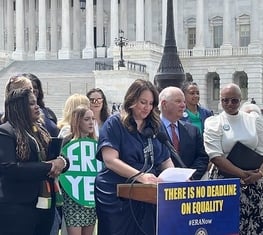Making Decisions Between Board Meetings
When the time frame for a decision on a matter normally requiring board action is too short to allow for full board consideration at its next meeting, the request or proposal shall be referred to the appropriate board committee chair and senior manager or to the Executive Committee.
The following questions shall be considered in determining whether or not the request/proposal should be approved.
- Will the request/proposal further a current LWVUS/LWVEF priority?
- Will the request/proposal enhance an important relationship with another organization?
- Will the request/proposal contribute to the organizational strength of the League?
- Will the resource demands associated with the request/proposal be appropriate, given existing organizational priorities and needs at all levels?
- Has the board approved similar proposals/requests in the past?
- If the proposals/requests are initiated by another organization, has the LWVUS/LWVEF worked with that organization in the past, and was that a positive experience?
If the committee chair and senior manager believe the issues are clear-cut, they may go ahead and make the decision on the proposal. If the issues are not clear-cut, they shall consult with the President/Chair and together decide whether to approve the proposal. If no decision can be made at this point, the proposal may be referred to the Executive Committee or to the full board. A meeting of the full board by email is appropriate under certain circumstances. The use of e-meetings shall be reserved for those issues needing a decision before an in-person meeting of the Board is scheduled. Each e-meeting agenda shall consist of a single issue.
The following should guide the conduct of e-meetings:
- To use e-meetings, all members of the involved group must have access to e-mail and must be aware that there may be e-meetings from time to time.
- The sequence of events will be as follows:
- The presiding officer will send out notification of an e-meeting, to begin on a date 6 days hence, providing the agenda item for discussion, the anticipated duration of the e-meeting after it has been initiated and the projected date to request a vote on the item.
- If a majority of the board members is available to participate, the e-meeting will proceed as scheduled. Lack of a majority will require rescheduling the e-meeting.
- On the designated start date, the presiding officer shall call the meeting to order by posting the agenda again, and attaching any needed supporting documentation, and will request each member to "sign in" to the e-meeting.
- Members are deemed present when they respond to the request for sign-in.
- When the e-meeting occurs, a majority of the board members shall constitute a quorum for an e-meeting and, once established, it shall be assumed that a quorum is present until the e-meeting is adjourned.
- Any member may post a motion. Then other members may post debate. The board shall establish how many motions, if more than one, can be under consideration at one time, which specific secondary motions may be offered, and which motions that bring a question again before the assembly will be allowed during an e-meeting.
- The presiding officer puts the question to a vote and designates that members must cast their vote within 2 days. Once a vote is cast, it cannot be changed.
- The presiding officer announces the result of the vote to the meeting participants.
- Board procedures for minutes shall be the same for e-meetings as for face-to-face meetings.
All decisions made between board meetings shall be reported to the full board in a timely manner.




